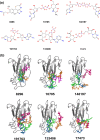Structure-based identification of small-molecule inhibitors that target the DIII domain of the Dengue virus glycoprotein E pan-serotypically
- PMID: 39453957
- PMCID: PMC11508475
- DOI: 10.1371/journal.pone.0311548
Structure-based identification of small-molecule inhibitors that target the DIII domain of the Dengue virus glycoprotein E pan-serotypically
Abstract
Dengue viral infection is caused by the Dengue virus, which spreads to humans through the bite of infected mosquitos. Dengue affects over half of the global population, with an estimated 500 million infections per year. Despite this, no effective treatment is currently available, however, several promising candidates are undergoing pre-clinical/clinical testing. The existence of four major serotypes is an important challenge in the development of drugs and vaccines to combat Dengue virus infection. Hence, the drug/vaccine thereby developed should neutralize all the four serotypes equally. However, there is no pan-serotype specific treatment for Dengue virus, thereby emphasizing the need for the identification of novel drug-like compounds that can target all serotypes of the Dengue virus equally. To this end, we employed virtual screening methodologies to find drug-like compounds that target the domain III of glycoprotein E. Most importantly, domain III of E protein is involved in viral fusion with the host membrane and is also targeted by neutralizing antibodies. Our study found two small molecule drug-like compounds (out of the 3 million compounds screened) having similar binding affinity with all four serotypes. The compounds thereby identified exhibit favourable drug like properties and can be developed as a treatment for Dengue virus.
Copyright: © 2024 Agrawal et al. This is an open access article distributed under the terms of the Creative Commons Attribution License, which permits unrestricted use, distribution, and reproduction in any medium, provided the original author and source are credited.
Conflict of interest statement
The authors have declared that no competing interests exist.
Figures





Similar articles
-
Discovery of Potent Inhibitors for the Inhibition of Dengue Envelope Protein: An In Silico Approach.Curr Top Med Chem. 2018;18(18):1585-1602. doi: 10.2174/1568026618666181025100736. Curr Top Med Chem. 2018. PMID: 30360716 Review.
-
Discovery of Immunologically Inspired Small Molecules That Target the Viral Envelope Protein.ACS Infect Dis. 2018 Sep 14;4(9):1395-1406. doi: 10.1021/acsinfecdis.8b00127. Epub 2018 Aug 29. ACS Infect Dis. 2018. PMID: 30027735 Free PMC article.
-
In Silico Evaluation of Potential Hit Molecules Against Multiple Serotypes of Dengue Virus Envelope Glycoprotein.Molecules. 2025 Mar 12;30(6):1268. doi: 10.3390/molecules30061268. Molecules. 2025. PMID: 40142044 Free PMC article.
-
De novo design approaches targeting an envelope protein pocket to identify small molecules against dengue virus.Eur J Med Chem. 2019 Nov 15;182:111628. doi: 10.1016/j.ejmech.2019.111628. Epub 2019 Aug 15. Eur J Med Chem. 2019. PMID: 31472473
-
Structure-Based Design of Antivirals against Envelope Glycoprotein of Dengue Virus.Viruses. 2020 Mar 26;12(4):367. doi: 10.3390/v12040367. Viruses. 2020. PMID: 32225021 Free PMC article. Review.
References
-
- Dengue- Global situation. [cited 10 Mar 2024]. Available: https://www.who.int/emergencies/disease-outbreak-news/item/2023-DON498.
-
- Budigi Y, Ong EZ, Robinson LN, Ong LC, Rowley KJ, Winnett A, et al.. Neutralization of antibody-enhanced Dengue virus infection by VIS513, a pan-serotype reactive monoclonal antibody targeting domain III of the Dengue virus E protein. PLoS Negl Trop Dis. 2018;12: e0006209. doi: 10.1371/journal.pntd.0006209 - DOI - PMC - PubMed
-
- AbViro LLC. A Phase 1a, Double-Blind, Placebo-Controlled, Single Ascending Dose Study to Determine the Safety and Pharmacokinetics of AV-1 in Healthy Male and Female Adult Subjects. clinicaltrials.gov; 2022. Oct. Report No.: NCT04273217. Available: https://clinicaltrials.gov/study/NCT04273217.
MeSH terms
Substances
LinkOut - more resources
Full Text Sources

